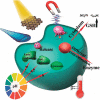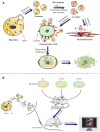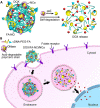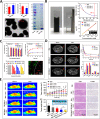Nanosized drug delivery strategies in osteosarcoma chemotherapy
- PMID: 36845905
- PMCID: PMC9957606
- DOI: 10.1063/5.0137026
Nanosized drug delivery strategies in osteosarcoma chemotherapy
Abstract
Despite recent developments worldwide in the therapeutic care of osteosarcoma (OS), the ongoing challenges in overcoming limitations and side effects of chemotherapy drugs warrant new strategies to improve overall patient survival. Spurred by rapid progress in biomedicine, nanobiotechnology, and materials chemistry, chemotherapeutic drug delivery in treatment of OS has become possible in recent years. Here, we review recent advances in the design of drug delivery system, especially for chemotherapeutic drugs in OS, and discuss the relative merits in trials along with future therapeutic options. These advances may pave the way for novel therapies requisite for patients with OS.
© 2023 Author(s).
Figures





Similar articles
-
Drug delivery nanocarriers and recent advances ventured to improve therapeutic efficacy against osteosarcoma: an overview.J Egypt Natl Canc Inst. 2021 Feb 8;33(1):4. doi: 10.1186/s43046-021-00059-3. J Egypt Natl Canc Inst. 2021. PMID: 33555490 Review.
-
Recent advances of drug delivery nanocarriers in osteosarcoma treatment.J Cancer. 2020 Jan 1;11(1):69-82. doi: 10.7150/jca.36588. eCollection 2020. J Cancer. 2020. PMID: 31892974 Free PMC article. Review.
-
Immunotherapy for osteosarcoma: Fundamental mechanism, rationale, and recent breakthroughs.Cancer Lett. 2021 Mar 1;500:1-10. doi: 10.1016/j.canlet.2020.12.024. Epub 2020 Dec 23. Cancer Lett. 2021. PMID: 33359211 Review.
-
Targeted Delivery of Chemotherapeutic Agents for Osteosarcoma Treatment.Front Oncol. 2022 Mar 4;12:843345. doi: 10.3389/fonc.2022.843345. eCollection 2022. Front Oncol. 2022. PMID: 35311145 Free PMC article. Review.
-
Recent Advances in Nanoplatforms for the Treatment of Osteosarcoma.Front Oncol. 2022 Feb 15;12:805978. doi: 10.3389/fonc.2022.805978. eCollection 2022. Front Oncol. 2022. PMID: 35242707 Free PMC article. Review.
Cited by
-
Oncolytic Viral Therapy in Osteosarcoma.Viruses. 2024 Jul 16;16(7):1139. doi: 10.3390/v16071139. Viruses. 2024. PMID: 39066301 Free PMC article. Review.
-
Material-Driven Therapeutics: Functional Nanomaterial Design Paradigms Revolutionizing Osteosarcoma Treatment.J Funct Biomater. 2025 Jun 5;16(6):213. doi: 10.3390/jfb16060213. J Funct Biomater. 2025. PMID: 40558899 Free PMC article. Review.
-
An update on the advances in the field of nanostructured drug delivery systems for a variety of orthopedic applications.Drug Deliv. 2023 Dec;30(1):2241667. doi: 10.1080/10717544.2023.2241667. Epub 2023 Dec 1. Drug Deliv. 2023. PMID: 38037335 Free PMC article.
-
Cancer treatment approaches within the frame of hyperthermia, drug delivery systems, and biosensors: concepts and future potentials.RSC Adv. 2024 Dec 12;14(53):39297-39324. doi: 10.1039/d4ra06992g. eCollection 2024 Dec 10. RSC Adv. 2024. PMID: 39670162 Free PMC article. Review.
-
Development of a KRP-based pH-responsive drug delivery system for solid tumors.Transl Cancer Res. 2025 Jun 30;14(6):3812-3821. doi: 10.21037/tcr-2025-1151. Epub 2025 Jun 27. Transl Cancer Res. 2025. PMID: 40687241 Free PMC article.
References
-
- Chen C., Zhang H., Yu Y., Huang Q., Wang W., Niu J., Lou J., Ren T., Huang Y., and Guo W., “ Chloroquine suppresses proliferation and invasion and induces apoptosis of osteosarcoma cells associated with inhibition of phosphorylation of STAT3,” Aging 13(13), 17901–17913 (2021).10.18632/aging.203196 - DOI - PMC - PubMed
-
- Heng M., Gupta A., Chung P. W., Healey J. H., Vaynrub M., Rose P. S., Houdek M. T., Lin P. P., Bishop A. J., Hornicek F. J., Chen Y. L., Lozano-Calderon S., Holt G. E., Han I., Biau D., Niu X., Bernthal N. M., Ferguson P. C., and Wunder J. S., “ The role of chemotherapy and radiotherapy in localized extraskeletal osteosarcoma,” Eur. J. Cancer 125, 130–141 (2020).10.1016/j.ejca.2019.07.029 - DOI - PMC - PubMed
Publication types
LinkOut - more resources
Full Text Sources

